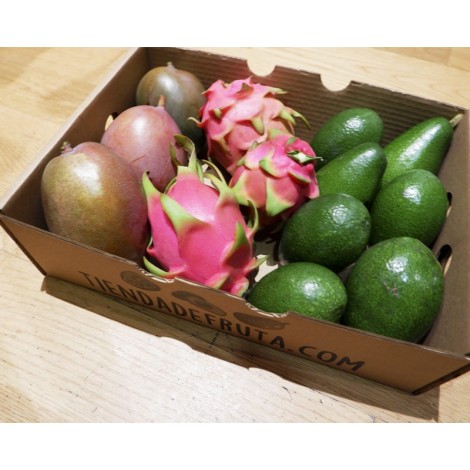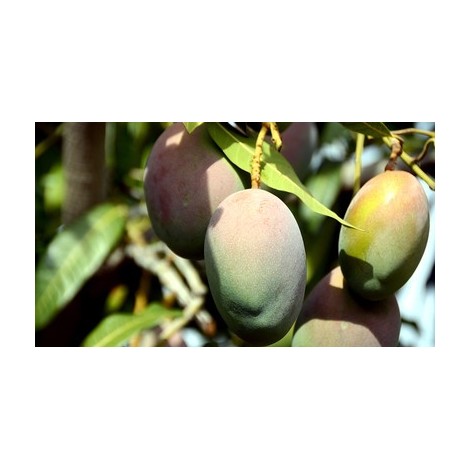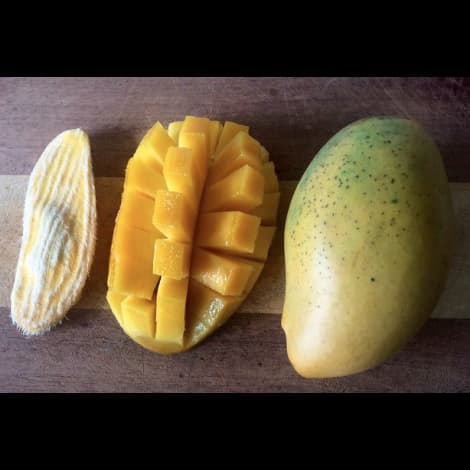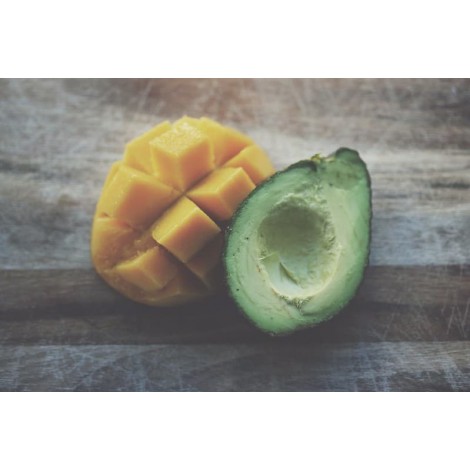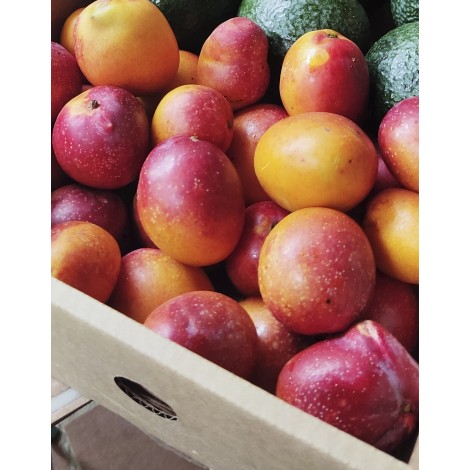Mango fruit
Mango fruit
BUY MANGOS HERE
What is the mango fruit like?
The mango is a very consumed tropical fruit, known for its juicy orange pulp. It's a good source of fiber and vitamin C. Additionally, it's said that mango has anticancer potential, partly due to its antioxidant content. In the kitchen, mango can be used in a wide variety of dishes. It can be combined with both sweet and savory dishes. Moreover, healthy and delicious dishes can be made with mango.
What is the mango fruit good for?
Characteristics of the mango
What properties does the mango fruit have?
Among the nutrients present in good amounts in mango, we can mention the following:
Vitamin A: Mango is a source of vitamin A Vitamin C: Mango is a good source of vitamin C Vitamin B1 also known as thiamine: Mango is rich in vitamin B1 Vitamin B2 known as riboflavin: Mango is a source of vitamin B2 only for women Vitamin B6 (pyridoxine): Mango is a source of vitamin B6 Vitamin E: Mango is a source of vitamin E Copper: Mango is an alternative source of copper
The benefits of mango
Several prospective and epidemiological studies have demonstrated that a high consumption of fruits and vegetables reduces the risk of cardiovascular diseases, certain types of cancer, and other chronic diseases. The presence of antioxidants in fruits and vegetables may play a role in these protective effects.
Mango fruit properties
One of the few studies specifically on mango demonstrated that mango juice had an anticancer effect on cells in vitro. However, more studies are needed to determine if these properties persist after the juice is digested or absorbed by the human body.
In general, the anticancer effect of mangos can be explained by their content in polyphenols. Additionally, it appears that the Haden and Ataulfo varieties have a higher preventive activity than others.
Mango fruit:
Mango has a high concentration of polyphenols like guava and lychee.
Phenolic compounds are found in plant-based foods. They have antioxidant capacity that protects the body's cells from damage caused by free radicals.
Mango tropical fruit
It is believed that they reduce the risk of various diseases. Their abundance and composition differ from one variety to another. For example, the Ataulfo variety is said to contain more polyphenols, vitamin C, and beta-carotene and have a higher antioxidant capacity than the Tommy Atkins, Haden, Kent, and Keitt varieties.
The concentration of phenolic compounds can also vary greatly among fruits of the same variety, within the same crop, and with similar ripeness. Do you want to learn how to RIPEN A MANGO correctly? Visit our blog.
Mango fruit
The main polyphenol found in a ripe mango is gallic acid.
Mangos also contain mangiferin and gallotannins, as well as tannins. However, it is believed that these 3 compounds are present in much greater proportions in the seed and skin of the fruit. Mangiferin has been studied mainly from extracts of mango peel.
Studies attribute beneficial properties to mango against diabetes, inflammation, oxidative stress, and hypercholesterolemia. However, it is said that mango contains 400 times less mangiferin than the bark of the tree, which is not enough to produce the observed effects.
Manga fruit: An excellent source of carotenoids
The main carotenoids of mango are beta-carotene and violaxanthin.
These pigments have antioxidant properties and give a reddish-orange color to foods containing them in large quantities, like mango. In some mango varieties, it's estimated that beta-carotene accounts for between 20% and nearly 100% of the total carotenoids.
Beta-carotene is an important precursor of vitamin A in the body. However, the different varieties of mango, as well as the ripeness phase, greatly influence the amounts of these carotenoids.
A study has shown that ripe mango has higher antioxidant activity than unripe fruit.
Mangos also contain other types of carotenoids, such as beta-cryptoxanthin, but in smaller quantities.
Mango fruit: Rich in soluble fiber
The edible part of the mango contains fiber, half of which is soluble fiber. Its proportion tends to increase as the fruit ripens. Soluble fiber helps reduce the risk of cardiovascular diseases thanks to its ability to reduce blood cholesterol.
Most of the soluble fiber in mango is in the form of pectin in quantities comparable to those of apples or bananas, two fruits known for their high pectin content.
A word from the nutritionist
When your stomach hurts or after a period when you've overeaten, consider adding green mango to your diet. In fact, before it's fully ripe, green mango can be grated and eaten in salad and would be ideal for relieving stomach pains and helping the liver detox.
Mangas fruit: How to choose the right mango?
The mango is the fruit of the mango tree and belongs to the Anacardiaceae family, like cashew. It's believed to be native to India, Pakistan, and Burma, where it still grows wild. In France, mango can be found on shelves from December to February, although it's available almost all year round in most supermarkets because it's imported from other regions of the world.
Mango fruit origin
Mango is a quite fragile fruit. To get the best flavor, it's recommended to choose a mango that's soft but still firm. The skin should be well colored, without spots or bruises. The fragrance of the mango should be subtle and pleasant. It's better not to rely on its color, as this varies from one variety to another and is not necessarily a sign of ripeness.
How to store mango?
Mango should be stored in a cool, dry place, but never in the refrigerator.
In fact, it does not tolerate temperatures below 8°C and would risk losing all its flavor. Stored at room temperature, it should be consumed quickly when ripe.
When does mango season start in Spain?
The mango season on our farm starts at the end of July with the BABY PRIMA FIORI MANGOS
a real treat with a candy-like flavor
Mango fruit seed
The peel and seed of the mango represent approximately 25% and 20% of the










